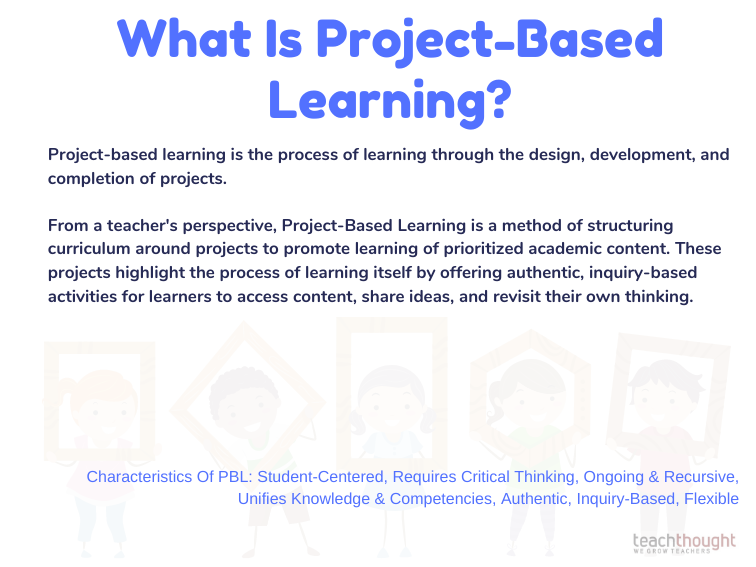
Project-Based Learning? A Definition.
by Terry Heick
In one sentence, project-based learning (PBL) is the process of learning through projects.
To be a bit more specific, PBL is the process of learning through the design, development, and completion of projects.
It can be useful to think of it in terms of what it’s not–The Difference Between Projects And Project-Based Learning, for example. PBL is not completing projects or it’d be called ‘Learning-Based Projects’–or just ‘projects.’ In quality PBL, the goal is learning and the projects help facilitate that learning. That is, projects act as vehicles.
PBL depends on background knowledge, learner choice, technology tools, support from others, and dozens of other factors that result in a process of learning that produces very different results and ‘projects’
In 3 Types Of Project-Based Learning, we gave a definition for project-based learning that we’re using as a basis to push the idea a bit further.
Characteristics Of Project-Based Learning
What are the characteristics of PBL? According to Joseph S. Krajcik and Phyllis C. Blumenfeld in The Cambridge Handbook of the Learning Sciences (2006)–who quote the research of Blumenfeld et al., 1991; Krajcik, et al., 1994; Krajcik, Czerniak, & Berger, 2002)–PBL experiences:
“They start with a driving question, a problem to be solved.
Students explore the driving question by participating in authentic, situated inquiry – processes of problem-solving that are central to expert performance in the discipline. As students explore the driving question, they learn and apply important ideas in the discipline.
Students, teachers, and community members engage in collaborative activities to find solutions to the driving question. This mirrors the complex social situation of expert problem-solving.
While engaged in the inquiry process, students are scaffolding with learning technologies that help them participate in activities normally beyond their ability.
Students create a set of tangible products that address the driving question. These are shared artifacts, publicly accessible external representations of the class’s learning.”
Benefits Of Project-Based Learning
- Requires critical thinking (e.g., design, evaluation, analysis, judgment, prioritizing, etc.). This is in contrast to other forms of learning that hope to ‘promote’ critical thinking but can be accomplished without it.
- Driven by inquiry
- Combines knowledge and competencies/skills
- Illuminates learning as iterative and recursive (as opposed to learn–>study–>assess–>move on)
- Flexible
- Authentic
- Student-Centered
- Unifies other disparate skills
- Easy to align with standards
Teaching Through Project-Based Learning
From a teacher’s perspective, Project-Based Learning is a method of structuring curriculum around projects to promote learning of prioritized academic content. These projects highlight the process of learning itself by offering authentic, inquiry-based activities for learners to access content, share ideas, and revisit their own thinking.
At the risk of becoming redundant, return again to the difference between projects and project-based learning–primarily that Project-Based Learning is about the process, and projects are about the product that comes at the end.
Project-Based Learning often requires students not simply to collect resources, organize work, and manage long-term activities, but also to collaborate, design, revise, and share their ideas and experiences with authentic audiences and supportive peer groups in the classroom, or within physical and digital communities the student is a member of and contributes to.
